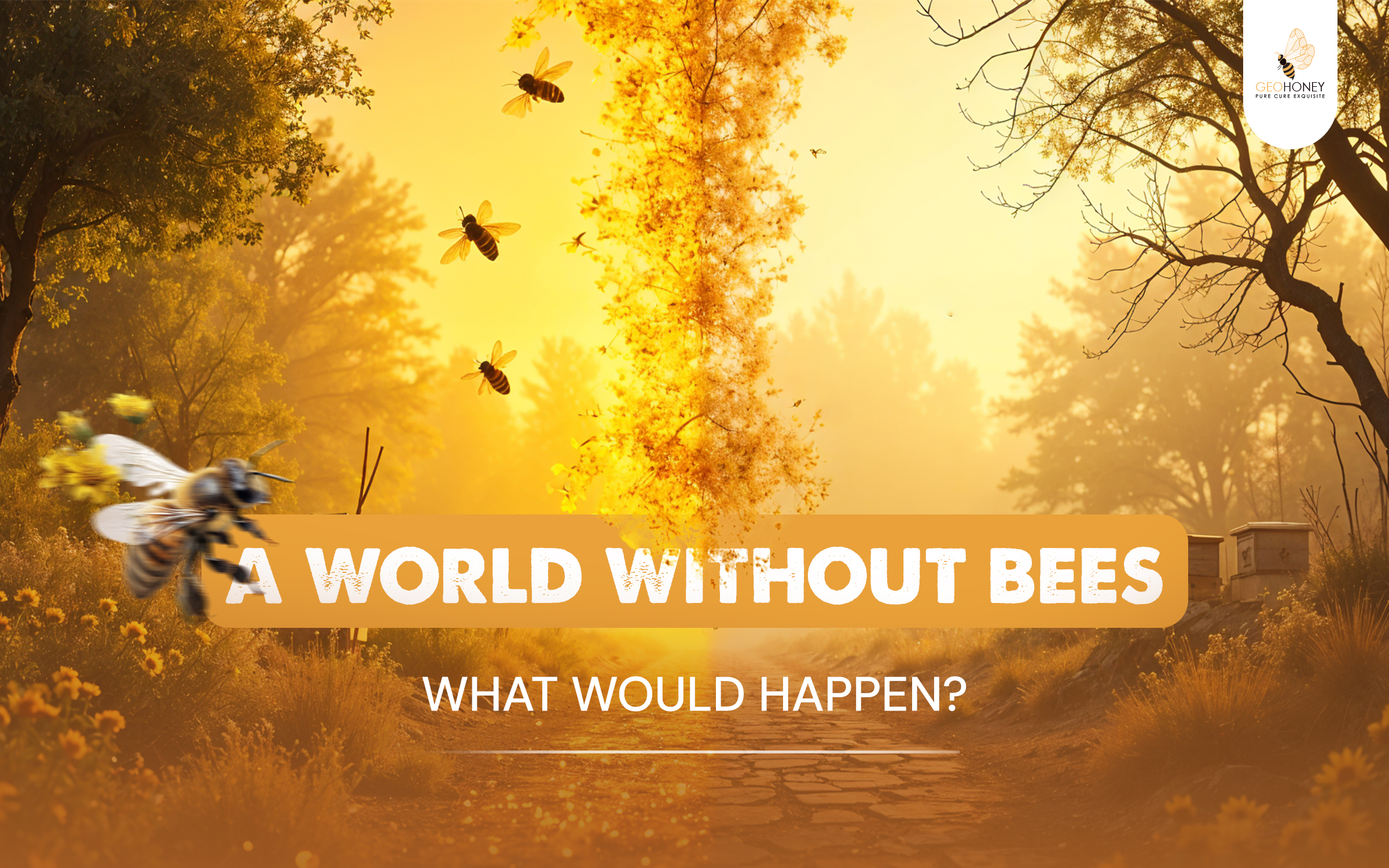- Tokyo: 09:21
- Singapore: 08:21
- Dubai: 04:21
- London: 00:21
- New York: 19:21
A World Without Bees: What Would Happen?

Honeybees are crucial to the existence of all living things on planet Earth. This keystone species does a lot more than just producing fresh honey, propolis or other raw materials you normally find from their hives.
These hardworking creatures are the most important pollinators, who pollinate more than 70% of all crops globally, which directly or indirectly feed 90% of the population.
A world without bees means a significant reduction in crop yields. This will, in turn, affect all animals that feed on these crops, eventually leading to their death and even extinction.
The founder of Geohoney and the CEO of B A Barry Group, Mr. Basem Barry, says
“Without honey bees, the entire global ecosystem, biodiversity and food chain will collapse in a matter of days.”
This blog delves into the far-reaching impacts of honeybee extinction. It highlights some key negative changes that will immediately ensue if bees somehow disappear from the planet, so keep on reading till the end.
Reasons Why Honeybee Populations are Declining Globally
What Would Happen if Bees Disappeared?
Reduced Crop Yields and Consequent Food Crisis
Ecosystem Collapse
Impacts on Livestock
Dangers to Biodiversity
Adverse Economic Consequences
Effective Bee Conservation Strategies
Reasons Why Honeybee Populations are Declining Globally
A study by the Joint Nature Conservation Committee (JNCC) of the UK shows that the number of pollinators has dropped by a staggering 25% since 1987.
If this trend continues, the honeybees and other pollinators will soon face a huge population decline, which will eventually lead to severe consequences for every ecosystem and living being of the planet.
This suggests there is an urgent need to educate the general population about the activities that contribute to this decline in the number of pollinators.
The following are some of the main reasons behind the decline of bee populations worldwide.
The use of pesticides on crops that bees forage leads to the weakening of their immune system and impaired navigation and reproductive capabilities, which directly leads to population decline.
Deforestation and urbanization lead to habitat loss or fragmentation, which kills millions of bees every year.
Modern agricultural practices focus on high-yield crop varieties and have no regard for flowering plants or wildflower preservation. This decline of wildflowers reduces floral sources that bees can visit, which leads to nutritional deficiencies and poor health of the bees.
Bees are also being increasingly affected by diseases and parasites like Varroa mite, Deformed Wing Virus (DWV), or Nosema, which affect their performance and shorten their lifespans.
What Would Happen if Bees Disappeared?
Honeybees are the main producers of organic honey that humans have been using for thousands of years. However, this is not the only role these tiny creatures play. The following are some major consequences of honeybee extinction that show why we must protect them at all costs.
Reduced Crop Yields and Consequent Food Crisis
The biggest effect will be the reduction of crop yields and variety if bees suddenly disappear. These creatures pollinate 90% of the crops that humans, livestock and other animals feed on.
Without them, a huge number of fruits, vegetables and nuts would have no way to reproduce and grow. Lower yields of the crops will lead to much higher food prices.
Apart from that, using artificial means of pollination will also lead to a drop in the quality of these crops. This can result in severe food scarcity and malnutrition.
Ecosystem Collapse
Apart from providing us with raw honey, bees also play a key role in creating a balanced ecosystem. Without bees, most plant species will go extinct, which will deal a severe blow to the ecosystem.
Without plant diversity, animals that feed on these plants will also starve and suffer a huge population decline. This will drastically alter the composition of the ecosystem and that will lead to an imbalance that will be nearly impossible to restore.
Impacts on Livestock
Livestock feed on grains, corn, oats, hay and similar plants. All of these plants need honeybees for their reproduction. With them gone, livestock around the globe will face severe malnutrition.
With a decline in livestock populations, key commodities like cheese, milk, meat, butter and other dairy products will also become very scarce.
Dangers to Biodiversity
Most plants and crops around the world rely on honeybees for their growth. With a decline in the bee population, the biodiversity of the planet will greatly suffer as the variety of plants that can grow will be very limited.
This will trigger a vicious chain reaction where a loss of flowers will create a decline in the bee population and this, in turn, will lead to even less pollination of the plants.
Another consequence of this is the loss of food and shelter for the herbivores. This will lead to fewer herbivores and that will create food scarcity for animals that feed on herbivores.
This will lead to the destruction of many key ecosystems around the planet. With this, the global biodiversity will suffer irreparable damage, making the planet much less habitable for every being.
Adverse Economic Consequences
Without bees, farmers, local beekeepers and major food processors will face severe financial strife. Every industry related to food processing will be disrupted, creating financial issues for employees at every level.
If bees are gone, $577 billion global food production and about $8.5 billion global honey market will suffer terribly. Reduced crop yields will destroy the farming sector, which is the economic backbone for most countries. This way, a world without bees will lack economic stability, making it hard for most people to earn a sustainable living.
Effective Bee Conservation Strategies
All of the above-mentioned consequences are completely avoidable if we follow the recommended bee conservation practices both in personal and collective capacities.
The following are a few things we can do to protect these pollinators.
Farmers can use integrated pest management methods that involve minimum pesticide usage and more targeted pest control methods to make sure bees are not exposed to these harmful elements.
Another effective approach is to create bee-friendly habitats and to restore existing ones. We can grow more wildflower meadows and pay attention to the conservation of natural landscapes to minimize habitat fragmentation.
Educating beekeepers about sustainable practices is another way to protect bees. Farmers can learn about hive management, disease diagnosis and prevention and regular pest monitoring to ensure their bees are safe at all times.
Another key thing to do is to educate the general public about the decline in the bee population and its consequences.
Collaboration between policymakers, researchers and communities is also important in creating and implementing better bee conservation policies.
Conclusion
Bees are responsible for global food security, ecosystem stability, biodiversity and a sustainable economy. Without these hardworking creatures, both humans and animals will face severe food shortages.
With the loss of biodiversity, plants and trees, other issues like global warming and climate change will also get even worse. This is why it is safe to say that honeybees are the ones keeping the planet stable and healthy.
But due to careless human activities, the population of these creatures is declining at an alarming rate. This situation needs to be addressed on a priority basis if we are to prevent this keystone species from going extinct.
By adopting better agricultural and beekeeping practices and paying attention to bee habitat restoration, it is possible to minimize the damage and ensure safety for the bees.
Visit us at Geohoney to explore our premium quality raw honey products sourced from the best honey producers from all over the globe.



